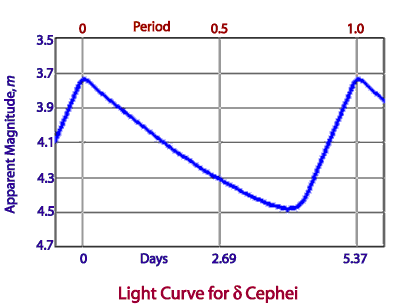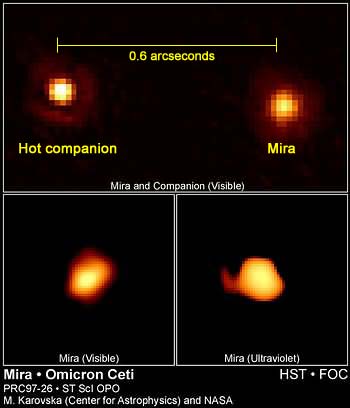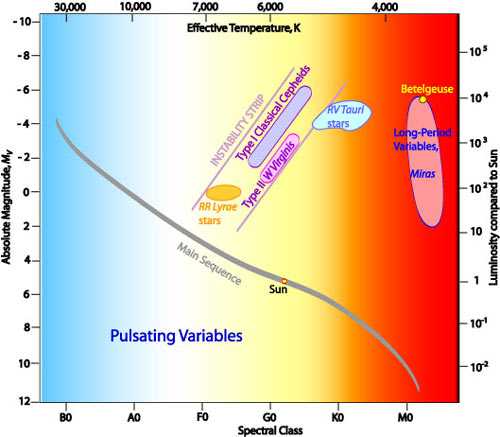Pulsating Variable Stars
Pulsating variable stars are intrinsic variables as their variation in brightness is due to a physical change within the star. In the case of pulsating variables this is due to the periodic expansion and contraction of the surface layers of the stars. This means the star actually increases and decreases in size periodically. The different types of pulsating variable are distinguished by their periods of pulsation and the shapes of their light curves. These in turn are a function of the mass and evolutionary stage of a given star.
The study of pulsating variables is of great importance to astronomers. Analysis of light curves provides vital information about the interior processes in stars. Perhaps their most valuable property of many types of pulsating variables is a direct relationship between the period of pulsation and their luminosity. This in turn allows us to determine the distance to such stars and is discussed in more detail on the next page.
As with non-pulsating variables, there are several types of pulsating stars and some of the key types are described briefly below.
Types of Pulsating Variables
In October 1595 the Dutchman David Fabricus observed the star ο Ceti to disappear. The same star was noted to vary in brightness during 1638-39 by another Dutch observer and became known as Mira (the "Wonderful") due to its behaviour. It was eventually found to have a period of about 334 days and was the first pulsating variable discovered. Its light curve was different to that of Algol which was correctly inferred to be an eclipsing binary by the brilliant young English astronomer John Goodricke in 1782.
Cepheids
Cepheids are very luminous, massive variables with periods of 1 -70 days. They are named after the first-such pulsating variable, δ Cephei discovered by John Goodricke in 1784. Cepheid light curves are distinctive and show a rapid rise in brightness followed by a more gradual decline, shaped like a shark fin. Their amplitude range is typically 0.5 to 2 magnitudes. The spectral class of a Cepheid actually changes as it pulsates, being about an F at maximum luminosity and down to a G or K at minimum.
There are in fact two types of Cepheids, the original Type I or Classical Cepheids of which δ Cephei is an example and the slightly dimmer Type II or W Virginis Cepheids. Both types are located in a region of the HR Diagram called the Instability Strip.
Type I Classical Cepheids
These stars take their name from δ Cephei. Most have a period of between 5 -10 days and an amplitude range of 0.5 - 2.0 magnitudes in visible light. The variations are less pronounced at infrared wavebands. They are 1.5 - 2 magnitudes more luminous than Type II Cepheids. The distinctive light curve for δ Cephei is shown below.

Classical Cepheids follow a well-defined period-luminosity relationship. This means that the longer the period of the Cepheid, the more intrinsically luminous it is. This has important implications as it allows Cepheids to be used as standard candles for distance determination and is discussed in detail on the next page
Type I Cepheids show are located on the Instability Strip of an HR diagram and are massive supergiant stars. Their pulsation mechanism is discussed in more detail below.
Type II W Virginis
Type II Cepheids are named after the first star identified in this group, W Virginis. It has a period of 17.2736 days, magnitude range of 9.46 - 10.75 and a spectral class range of F0Ib-G0Ib.
W Virginis -type Cepheids are intrinsically less luminous by 1.5 - 2 magnitudes than the Type I Classical Cepheids and have typical periods of 12 - 30 days. As they are older stars than Type Is their spectra are characterised by having lower metallicities. Type II light curves show a characteristic bump on the decline side and they have an amplitude range of 0.3 - 1.2 magnitudes.
As with the Type I Cepheids they also display a similar well-defined period-luminosity relationship and can be used for distance determination.
RR Lyrae
These old population II giant stars are mostly found in globular clusters. They are characterised by their short periods, usually about 1.5 hours to a day and have a brightness range of 0.3 to 2 magnitudes. Spectral classes range from A7 to F5. RR Lyrae stars are less massive than Cepheids but they also follow their own period - luminosity relationship, with a mean absolute magnitude of +0.6. They are thus useful in determining distances to the globular clusters within which they are commonly found to a distance of about 200 kiloparsecs. Sub-types are classified according to the shape of their light curves.
RR Lyraes fit on the Instability Strip on an HR diagram.
RV Tauri
RV Tauri variables are yellow supergiants, mostly G and K-class stars. Their distinctive light curves show alternating deep and shallow minima with the period equal to the time between two successive deep minima. Typical values are 20 - 100 days.
Long-Period Variables (LPVs)
The first pulsating variable discovered was the long-period variable Mira. They are cool red giants or supergiants and have periods of months to years. Their luminosities can range from 10 to 10,000 × LSun. Long-period variables are further classified according to whether they exhibit regular periodicity, such as the Miras or more irregular behaviour,
Mira -Type
Mira or ο Ceti, established as a variable in 1638 gives its name to stars of this type. Mira itself has a period of 331 days and varies its brightness by almost 6 magnitudes in the visible waveband during a cycle. A red giant, its radius varies by 20 percent, peaking at 330 times that of our Sun. Its effective temperature ranges from 1,900 K to 2,600 K. It is also a visual binary and its companion is also a variable star.

The Mira-type stars have long periods, ranging from about 80 to 1,000 days, varying by 2.5 to 10 magnitudes visually. Their high luminosities mean they can, at maximum brightness, be detected at large distances. They have tenuous outer layers in their atmospheres which get shocked and heated from the regular pulsations. This can give rise to emission lines in their spectra. Dust grains in their outer atmosphere get heated so they are strong emitters in infrared wavebands. They also show evidence of molecules in these regions.
Semiregular Variables (SR)
As their name implies, these stars whilst showing some periodicity and variations in brightness also exhibit irregularities where they appear to be stable. They are giant and supergiant stars with periods ranging from a few days to several years and the change in brightness is typically less than two magnitudes. The light curves of semiregulars have a variety of shapes. Prominent examples of this type include Antares, α Scorpius, and Betelgeuse, α Orionis.

Why Do Stars Pulsate?
We tend to think of stars as stable and unchanging. As we shall see in the next section on stellar evolution however, stars undergo several stages in their existence. Main sequence stars such as our Sun nonetheless are basically stable, exhibiting no dramatic changes in size or brightness. They are in what is called hydrostatic equilibrium, that is the gravitational force pulling the star's material inwards is balanced by the radiation pressure and the gas pressure. The radiation pressure acts outwards and arises from the production of photons in the core by fusion processes. Gas pressure is much the same as any gas on Earth resisting attempts to compress it. Why then do some stars pulsate?
Despite what you might think, pulsation is not due to increased radiation pressure from higher rates of fusion in the core. In fact pulsations arise not from the rate of fusion which remains constant in the core but instead from variations in the rate at which the radiation can escape from the star. Let us look at the steps involved in a pulsating stars:
- If the pressure outwards exceeds the gravitational force inwards, the outer layers of a star will expand outwards.
- As the star expands, its gravitational force inwards diminishes but its outwards pressure also drops at an even greater rate (think of what happens to a gas as it expands).
- Eventually the star would reach a position at which hydrostatic equilibrium occurs, that is gravity = pressure. However the outward moving layers still have momentum so resist a change in motion. This momentum carries the layer past the equilibrium position.
- As the gravitational force acts on the layer it slows down. A point is reached where it stops but now the outward gas and radiation pressure is weaker than the inward-acting gravitational force.
- The imbalance of forces now causes the star's outer layers to collapse inwards.
- As the layers collapse gravity increases but the pressure increases at a greater rate.
- With the pressure outwards exceeding the inwards gravitational force the collapsing layer slows down and eventually stops.
- We are now back at the start where the outwards pressure is greater than the gravitational force so the pulsation cycle starts again!
A pulsating star is thus not in equilibrium but is always trying to regain it but shooting past the point. It is an harmonic oscillator. Indeed analysis of light curves comprising many periods can often reveal more than one harmonic mode of oscillation for some types of pulsating variable. This information in turn allows astronomers to learn more about the interiors of those stars in much the same way as analysis of seismic waves helps geologists probe the Earth's interior.
